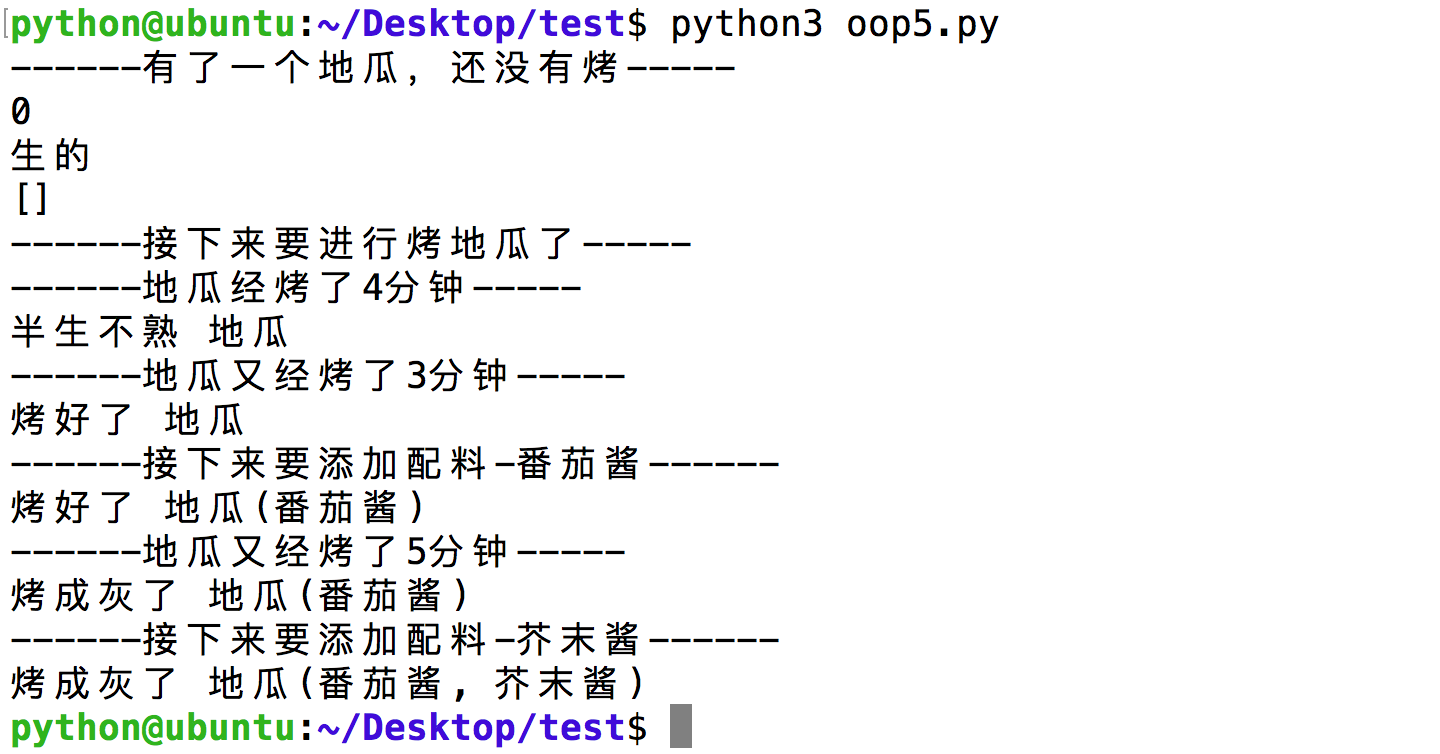应用:烤地瓜
为了更好的理解面向对象编程,下面以“烤地瓜”为案例,进行分析
定义地瓜类,存储烤熟的程度和添加的佐料,同时要提供烤地瓜和添加佐料的功能
1. 分析“烤地瓜”的属性和方法
示例属性如下:
- cookedLevel : 这是数字;0~3表示还是生的,超过3表示半生不熟,超过5表示已经烤好了,超过8表示已经烤成木炭了!我们的地瓜开始时时生的
- cookedString : 这是字符串;描述地瓜的生熟程度
- condiments : 这是地瓜的配料列表,比如番茄酱、芥末酱等
示例方法如下:
cook(): 把地瓜烤一段时间addCondiments(): 给地瓜添加配料__init__(): 设置默认的属性__str__(): 让print的结果看起来更好一些
2. 定义类,并且定义__init__()方法
#定义`地瓜`类
class SweetPotato:
'这是烤地瓜的类'
#定义初始化方法
def __init__(self):
self.cookedLevel = 0
self.cookedString = "生的"
self.condiments = []
3. 添加"烤地瓜"方法
#烤地瓜方法
def cook(self, time):
self.cookedLevel += time
if self.cookedLevel > 8:
self.cookedString = "烤成灰了"
elif self.cookedLevel > 5:
self.cookedString = "烤好了"
elif self.cookedLevel > 3:
self.cookedString = "半生不熟"
else:
self.cookedString = "生的"
4. 基本的功能已经有了一部分,赶紧测试一下
把上面2块代码合并为一个程序后,在代码的下面添加以下代码进行测试
mySweetPotato = SweetPotato()
print(mySweetPotato.cookedLevel)
print(mySweetPotato.cookedString)
print(mySweetPotato.condiments)
完整的代码为:
class SweetPotato:
'这是烤地瓜的类'
#定义初始化方法
def __init__(self):
self.cookedLevel = 0
self.cookedString = "生的"
self.condiments = []
#烤地瓜方法
def cook(self, time):
self.cookedLevel += time
if self.cookedLevel > 8:
self.cookedString = "烤成灰了"
elif self.cookedLevel > 5:
self.cookedString = "烤好了"
elif self.cookedLevel > 3:
self.cookedString = "半生不熟"
else:
self.cookedString = "生的"
# 用来进行测试
mySweetPotato = SweetPotato()
print(mySweetPotato.cookedLevel)
print(mySweetPotato.cookedString)
print(mySweetPotato.condiments)

5. 测试cook方法是否好用
在上面的代码最后面添加如下代码:
print("------接下来要进行烤地瓜了-----")
mySweetPotato.cook(4) #烤4分钟
print(mySweetPotato.cookedLevel)
print(mySweetPotato.cookedString)

6. 定义addCondiments()方法和__str__()方法
def __str__(self):
msg = self.cookedString + " 地瓜"
if len(self.condiments) > 0:
msg = msg + "("
for temp in self.condiments:
msg = msg + temp + ", "
msg = msg.strip(", ")
msg = msg + ")"
return msg
def addCondiments(self, condiments):
self.condiments.append(condiments)
7. 再次测试
完整的代码如下:
class SweetPotato:
"这是烤地瓜的类"
#定义初始化方法
def __init__(self):
self.cookedLevel = 0
self.cookedString = "生的"
self.condiments = []
#定制print时的显示内容
def __str__(self):
msg = self.cookedString + " 地瓜"
if len(self.condiments) > 0:
msg = msg + "("
for temp in self.condiments:
msg = msg + temp + ", "
msg = msg.strip(", ")
msg = msg + ")"
return msg
#烤地瓜方法
def cook(self, time):
self.cookedLevel += time
if self.cookedLevel > 8:
self.cookedString = "烤成灰了"
elif self.cookedLevel > 5:
self.cookedString = "烤好了"
elif self.cookedLevel > 3:
self.cookedString = "半生不熟"
else:
self.cookedString = "生的"
#添加配料
def addCondiments(self, condiments):
self.condiments.append(condiments)
# 用来进行测试
mySweetPotato = SweetPotato()
print("------有了一个地瓜,还没有烤-----")
print(mySweetPotato.cookedLevel)
print(mySweetPotato.cookedString)
print(mySweetPotato.condiments)
print("------接下来要进行烤地瓜了-----")
print("------地瓜经烤了4分钟-----")
mySweetPotato.cook(4) #烤4分钟
print(mySweetPotato)
print("------地瓜又经烤了3分钟-----")
mySweetPotato.cook(3) #又烤了3分钟
print(mySweetPotato)
print("------接下来要添加配料-番茄酱------")
mySweetPotato.addCondiments("番茄酱")
print(mySweetPotato)
print("------地瓜又经烤了5分钟-----")
mySweetPotato.cook(5) #又烤了5分钟
print(mySweetPotato)
print("------接下来要添加配料-芥末酱------")
mySweetPotato.addCondiments("芥末酱")
print(mySweetPotato)
